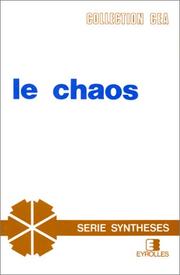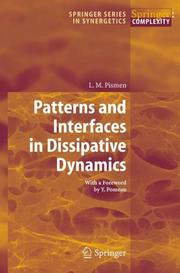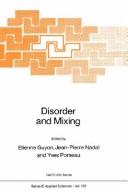| Listing 1 - 10 of 17 | << page >> |
Sort by
|
Book
Year: 1969 Publisher: Paris
Abstract | Keywords | Export | Availability | Bookmark
 Loading...
Loading...Choose an application
- Reference Manager
- EndNote
- RefWorks (Direct export to RefWorks)

ISBN: 1402009739 1402009720 9401003076 Year: 2002 Publisher: Dordrecht : Kluwer,
Abstract | Keywords | Export | Availability | Bookmark
 Loading...
Loading...Choose an application
- Reference Manager
- EndNote
- RefWorks (Direct export to RefWorks)
Nonlinear partial differential equations abound in modern physics. The problems arising in these fields lead to fascinating questions and, at the same time, progress in understanding the mathematical structures is of great importance to the models. Nevertheless, activity in one of the approaches is not always sufficiently in touch with developments in the other field. The book presents the joint efforts of mathematicians and physicists involved in modelling reactive flows, in particular superconductivity and superfluidity. Certain contributions are fundamental to an understanding of such cutting-edge research topics as rotating Bose-Einstein condensates, Kolmogorov-Zakharov solutions for weak turbulence equations, and the propagation of fronts in heterogeneous media.
Partial differential equations. --- Condensed matter. --- Physical chemistry. --- Continuum physics. --- Applied mathematics. --- Engineering mathematics. --- Partial Differential Equations. --- Condensed Matter Physics. --- Physical Chemistry. --- Classical and Continuum Physics. --- Applications of Mathematics. --- Engineering --- Engineering analysis --- Mathematical analysis --- Classical field theory --- Continuum physics --- Physics --- Continuum mechanics --- Chemistry, Theoretical --- Physical chemistry --- Theoretical chemistry --- Chemistry --- Condensed materials --- Condensed media --- Condensed phase --- Materials, Condensed --- Media, Condensed --- Phase, Condensed --- Liquids --- Matter --- Solids --- Partial differential equations --- Mathematics --- Supraconductivite --- Physique mathematique --- Equations de reaction-diffusion --- Congres
Book
ISBN: 0191545023 9780191545023 9780198826262 0198826265 9780198506256 0198506252 Year: 2010 Publisher: Oxford New York
Abstract | Keywords | Export | Availability | Bookmark
 Loading...
Loading...Choose an application
- Reference Manager
- EndNote
- RefWorks (Direct export to RefWorks)
We experience elasticity everywhere in daily life: in the straightening or curling of hairs, the irreversible deformations of car bodies after a crash, or the bouncing of elastic balls in table tennis or football. The theory of elasticity is essential to the recent developments of applied and fundamental science, such as the bio-mechanics of DNA filaments and other macro-molecules, and the animation of virtual characters in computer graphics and materials science. In this book, the emphasis is on the elasticity of thin bodies (plates, shells, rods) in connection with geometry. It covers such topics as the mechanics of hairs (curled and straight), the buckling instabilities of stressed plates, including folds and conical points appearing at larger stresses, the geometric rigidity of elastic shells, and the delamination of thin compressed films. It applies general methods of classical analysis, including advanced non-linear aspects (bifurcation theory, boundary layer analysis), to derive detailed, fully explicit solutions to specific problems. These theoretical concepts are discussed in connection with experiments. The book is self-contained. Mathematical prerequisites are vector analysis and differential equations. The book can serve as a concrete introduction to non-linear methods in analysis. -- 'A most welcome addition to the literature with a refreshingly new approach, first in that it discusses in depth how the differential geometry of surfaces is connected with the theory of elastic plates and shells, second in that, as a consequence of this perspective, it sheds new light and understanding on practical problems.'-Philippe Ciarlet, City University of Hong Kong --Book Jacket.
Elasticity --- Elastic properties --- Young's modulus --- Mathematical physics --- Matter --- Statics --- Rheology --- Strains and stresses --- Strength of materials --- Mathematics. --- Properties --- Mathematics
Book
Abstract | Keywords | Export | Availability | Bookmark
 Loading...
Loading...Choose an application
- Reference Manager
- EndNote
- RefWorks (Direct export to RefWorks)

Abstract | Keywords | Export | Availability | Bookmark
 Loading...
Loading...Choose an application
- Reference Manager
- EndNote
- RefWorks (Direct export to RefWorks)
Book
Abstract | Keywords | Export | Availability | Bookmark
 Loading...
Loading...Choose an application
- Reference Manager
- EndNote
- RefWorks (Direct export to RefWorks)
Chaos --- Vulgarisation --- Methodes mathematiques de la physique --- Chaos --- Vulgarisation --- Methodes mathematiques de la physique

ISBN: 1280625767 9786610625765 3540304312 3540304304 3642067808 Year: 2006 Publisher: Berlin : Springer,
Abstract | Keywords | Export | Availability | Bookmark
 Loading...
Loading...Choose an application
- Reference Manager
- EndNote
- RefWorks (Direct export to RefWorks)
Spontaneous pattern formation in nonlinear dissipative systems far from equilibrium is a paradigmatic case of emergent behaviour associated with complex systems. It is encountered in a great variety of settings, both in nature and technology, and has numerous applications ranging from nonlinear optics through solid and fluid mechanics, physical chemistry and chemical engineering to biology. Nature creates its variety of forms through spontaneous pattern formation and self-assembly, and this strategy is likely to be imitated by future biomorphic technologies. This book is a first-hand account by one of the leading players in this field, which gives in-depth descriptions of analytical methods elucidating the complex evolution of nonlinear dissipative systems, and brings the reader to the forefront of current research. The introductory chapter on the theory of dynamical systems is written with a view to applications of its powerful methods to spatial and spatio-temporal patterns. It is followed by two chapters treating moving interfaces, based largely on reaction-diffusion and phase-separating systems. The following two chapters on amplitude equations for patterns and waves describe universal phenomena generated by representative equations which can be derived for a variety of non-equilibrium systems originating in fluid mechanics, physical chemistry or nonlinear optics. This book addresses graduate students and non-specialists from the many related areas of applied mathematics, physical chemistry, chemical engineering and biology, as well as the seasoned scientist in search of a modern source of reference.
Dynamics. --- Open systems (Physics) --- Pattern formation (Physical sciences) --- Chaotic behavior in systems --- Systems, Open (Physics) --- Irreversible processes --- Physics --- Statistical mechanics --- Statistical physics --- Dynamical systems --- Kinetics --- Mathematics --- Mechanics, Analytic --- Force and energy --- Mechanics --- Statics --- Chemistry --- Mathematics. --- Statistical physics. --- Complex Systems. --- Classical and Continuum Physics. --- Math. Applications in Chemistry. --- Applications of Mathematics. --- Statistical Physics and Dynamical Systems. --- Mathematical statistics --- Math --- Science --- Statistical methods --- Dynamical systems. --- Continuum physics. --- Chemometrics. --- Applied mathematics. --- Engineering mathematics. --- Engineering --- Engineering analysis --- Mathematical analysis --- Chemistry, Analytic --- Analytical chemistry --- Classical field theory --- Continuum physics --- Continuum mechanics --- Measurement
Book
ISBN: 3030343944 3030343936 Year: 2019 Publisher: Cham : Springer International Publishing : Imprint: Springer,
Abstract | Keywords | Export | Availability | Bookmark
 Loading...
Loading...Choose an application
- Reference Manager
- EndNote
- RefWorks (Direct export to RefWorks)
This book provides an introduction to topics in non-equilibrium quantum statistical physics for both mathematicians and theoretical physicists. The first part introduces a kinetic equation, of Kolmogorov type, which is needed to describe an isolated atom (actually, in experiments, an ion) under the effect of a classical pumping electromagnetic field which keeps the atom in its excited state(s) together with the random emission of fluorescence photons which put it back into its ground state. The quantum kinetic theory developed in the second part is an extension of Boltzmann's classical (non-quantum) kinetic theory of a dilute gas of quantum bosons. This is the source of many interesting fundamental questions, particularly because, if the temperature is low enough, such a gas is known to have at equilibrium a transition, the Bose–Einstein transition, where a finite portion of the particles stay in the quantum ground state. An important question considered is how a Bose gas condensate develops in time if its energy is initially low enough.
Quantum statistics --- Quantum theory --- Computer programs. --- Quantum dynamics --- Quantum mechanics --- Quantum physics --- Physics --- Mechanics --- Thermodynamics --- Quantum statistical mechanics --- Matrix mechanics --- Statistical mechanics --- Wave mechanics --- Statistical physics. --- Partial differential equations. --- Statistical Physics and Dynamical Systems. --- Partial Differential Equations. --- Partial differential equations --- Mathematical statistics --- Statistical methods

ISBN: 9024737885 9024737893 Year: 1988 Volume: vol 152 Publisher: Dordrecht Kluwer
Abstract | Keywords | Export | Availability | Bookmark
 Loading...
Loading...Choose an application
- Reference Manager
- EndNote
- RefWorks (Direct export to RefWorks)
Stochastic processes --- Chemical technology --- Fluid mechanics --- Mixing --- Congresses --- Diffusion --- Mélange. --- Ordre et désordre (physique). --- Physique statistique. --- Génie chimique. --- Order-disorder models --- Chemical engineering --- Statistical physics
Book
ISBN: 2738102344 9782738102348 Year: 1994 Publisher: Paris: Odile Jacob,
Abstract | Keywords | Export | Availability | Bookmark
 Loading...
Loading...Choose an application
- Reference Manager
- EndNote
- RefWorks (Direct export to RefWorks)
Chaotic behavior in systems. --- Cycles. --- 123 --- Vrijheid. Noodzakelijkheid. Indeterminisme. Determinisme --- 123 Vrijheid. Noodzakelijkheid. Indeterminisme. Determinisme --- Cyclic theory --- Natural cycles --- Periodicity --- Philosophy --- Rhythm --- Chaos in systems --- Chaos theory --- Chaotic motion in systems --- Differentiable dynamical systems --- Dynamics --- Nonlinear theories --- System theory --- Cycles --- Chaotic behavior in systems --- Chaos (théorie des systèmes)
| Listing 1 - 10 of 17 | << page >> |
Sort by
|

 Search
Search Feedback
Feedback About UniCat
About UniCat  Help
Help News
News